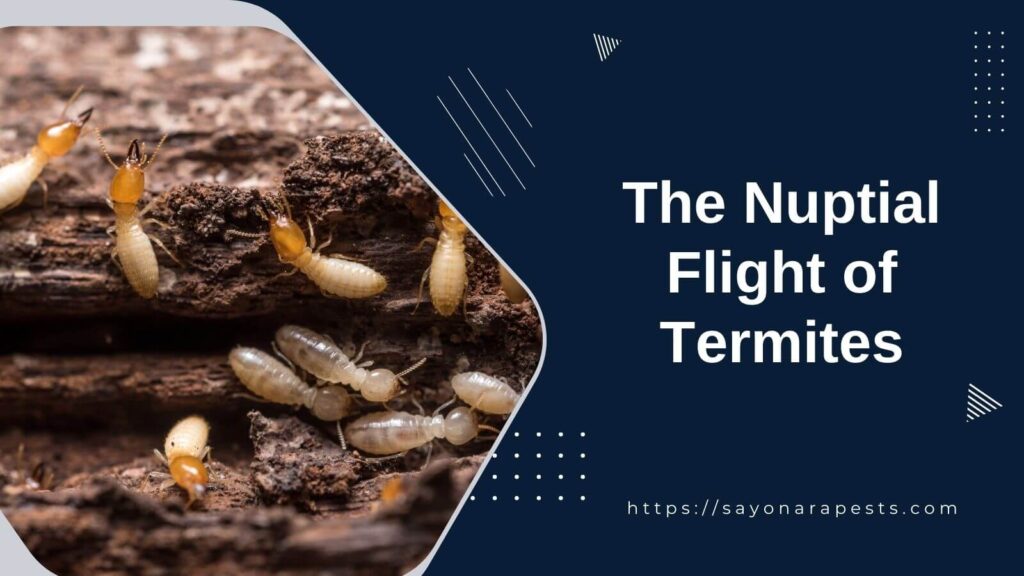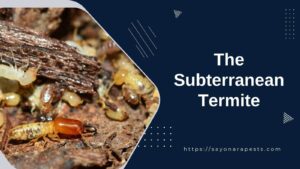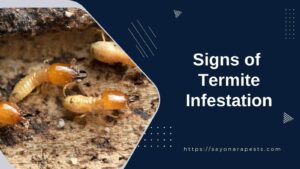The Nuptial Flight of Termites is a natural phenomenon that is shrouded in mystery and awe. This event occurs when winged reproductive termites, known as alates, leave their nests in search of a mate and a new location to establish a colony.
The nuptial flight is an essential part of the termite life cycle, and it is a critical moment for termite control specialists, homeowners, and property managers who are concerned about termite infestations.
Understanding the mechanisms that drive the nuptial flight is crucial for developing effective pest control strategies that can prevent termite infestations and minimize damage to buildings and structures.
Termites are social insects that live in colonies, and each colony has a queen and a king that are responsible for reproducing and maintaining the colony. The nuptial flight is the only time when winged alates leave the safety of their colony to mate and establish new colonies.
During the nuptial flight, millions of alates take to the air in a massive swarm that can last for hours or even days. The sheer number of termites involved in this event is staggering, and the sight of the swarm can be overwhelming.
The nuptial flight is a highly complex and synchronized event that involves a complex set of cues and signals that trigger the emergence of the alates.
The importance of understanding the nuptial flight of termites cannot be overstated. Termites are one of the most destructive pests that homeowners and property managers face, and they cause billions of dollars in damage each year.
The nuptial flight is a critical moment for termite control specialists, as it is the time when they can identify the location of termite colonies and take steps to prevent infestations. By understanding the mechanisms that drive the nuptial flight, pest control specialists can develop effective baiting and monitoring strategies that can prevent termite infestations from taking hold.
In this article, we will explore the fascinating world of termite nuptial flight. We will delve into the intricate signaling mechanisms that trigger the nuptial flight, and we will examine the factors that influence the timing and duration of the swarm.
We will also discuss the role of pheromones and other chemical signals in nuptial flight and explore the ways in which termite control specialists use these signals to detect and prevent infestations. Finally, we will examine the impact of climate change and other environmental factors on termite nuptial flight and explore the implications of these changes for termite control in the future.
What is Termite Nuptial Flight
The concept of termite nuptial flight is one that has puzzled scientists and nature enthusiasts alike for years. The nuptial flight is a process that is unique to termites and is an important part of their reproductive cycle.
In simple terms, nuptial flight is the process by which adult termites leave their colonies to find mates and establish new colonies. During this process, the winged termites, also known as alates, take to the air in large numbers, creating an impressive display that can be seen for miles around.
The nuptial flight is a highly synchronized event that occurs only once a year in most termite species. The timing of the flight is determined by a variety of factors, including temperature, humidity, and the phase of the moon.
These environmental cues ensure that all the termites in a given colony are ready to take flight at the same time, maximizing the chances of successful mating and colony establishment.
During the nuptial flight, male and female termites fly together in large swarms. The males, which are smaller than the females, have one job – to fertilize as many females as possible.
The females, on the other hand, are tasked with finding a suitable place to start a new colony. Once they have mated, the females shed their wings and burrow into the soil to lay their eggs and start a new colony.
The nuptial flight is an essential part of the termite life cycle, as it allows them to disperse and establish new colonies in different locations. It is also a fascinating natural phenomenon that has captured the imagination of people for centuries.
However, despite the wealth of information that is available on the nuptial flight, there is still much that is not known about this complex process. Scientists continue to study termites and their behavior in the hopes of unlocking more of the mysteries surrounding this unique and intriguing insect species.
Nuptial Flight Preparations of Termites
Prior to the nuptial flight, termite colonies undergo a period of preparation that can last anywhere from several weeks to several months. During this time, the colony produces alates, which are equipped with wings and reproductive organs.
These alates are typically larger in size than the workers and soldiers, and their wings are longer and more slender. In addition, the alates are fed a special diet that is rich in nutrients, which allows them to build up the energy reserves needed for their flight.
As the time for the nuptial flight approaches, the alates begin to swarm around the nest, waiting for the right conditions to take flight. The exact timing of the nuptial flight is critical, as it must coincide with the optimal weather conditions in order for the alates to successfully mate and establish new colonies.
Once the conditions are right, the alates take to the air in a spectacular display of synchronicity, with thousands of individuals taking flight at the same time.
The process of termite nuptial flight is a remarkable example of the complexity and beauty of the natural world. It is a testament to the intricacies of insect behavior and ecology, and a reminder of the wonders that can be found in even the smallest and seemingly insignificant creatures.
Overview of the Nuptial Flight of Termites
The Nuptial Flight of Termites is a fascinating natural phenomenon that occurs when reproductive termites swarm out of their colonies in search of a mate and a new location to start a new colony. The termite nuptial flight process is a highly anticipated event for termites and other creatures in the surrounding environment.
During the nuptial flight, swarms of winged termites emerge from their colonies and take to the air, where they engage in a mating frenzy that lasts for several hours.
The nuptial flight process of termites begins with the development of the winged reproductive caste within the colony. These reproductive termites are produced by the queen and king termites, and they are specifically designed to mate and start new colonies.
When the weather conditions are favorable, usually on warm and humid days, the winged reproductive termites emerge from their nests in large numbers, ready to mate and disperse.
The nuptial flight of termites is a highly coordinated event, and the winged termites are known to fly in synchrony, creating a mesmerizing spectacle in the sky. The termites are also attracted to light sources, which is why they are commonly seen swarming around streetlights and porch lights.
During the nuptial flight, male and female termites engage in a brief courtship, after which they mate and then disperse to start a new colony.
Overall, the nuptial flight process of termites is a crucial aspect of their reproductive cycle, and it plays an essential role in the continuation of their species.
The nuptial flight is a unique natural phenomenon that is both fascinating and awe-inspiring, and it is a testament to the incredible adaptations and behaviors of termites.
Despite their small size, termites play a critical role in the ecology of our planet, and their nuptial flight is just one of the many ways in which they contribute to the natural world.
When Does Termite Nuptial Flight Occur?
Factors that Trigger Termite Nuptial Flight
When discussing the timing of termite nuptial flight, it’s important to consider the various factors that trigger this event. There are numerous factors that come into play, ranging from environmental conditions to genetic and hormonal factors that are unique to each termite species.
One of the primary factors that trigger termite nuptial flight is the onset of rainy seasons. Many termite species require moist conditions in order to mate and establish new colonies. As such, the onset of rainy seasons, particularly in tropical regions, is a key trigger for termite nuptial flight.
This is because the rainwater softens the soil and makes it easier for the termites to dig their way out of their underground colonies and take to the skies.
Another key trigger for termite nuptial flight is temperature. In general, termites tend to prefer warm, humid conditions, as these conditions promote the growth of the fungi that they rely on for food.
However, different termite species have different temperature requirements, and some may only engage in nuptial flight during specific temperature ranges.
In addition to environmental factors, genetic and hormonal factors also play a role in termite nuptial flight. For example, some termite species may have genetic triggers that cause them to engage in nuptial flight at specific times of the year, regardless of environmental conditions.
Similarly, hormones produced by the termite queen may trigger nuptial flight in response to colony size or other factors.
Overall, the triggers for termite nuptial flight are complex and multifaceted. While environmental factors such as rainfall and temperature are key drivers, genetic and hormonal factors also play a role in determining when and how termites mate and establish new colonies.
Understanding these factors is crucial for scientists and pest control experts looking to better understand termite behavior and develop effective strategies for controlling termite infestations.
Overview of the Timing of Termite Nuptial Flight in Different Regions
The Nuptial Flight of Termites is a fascinating natural phenomenon that occurs in different regions worldwide. Understanding when this event occurs is crucial in predicting the movements of these insects and how they interact with their environment.
The timing of Termite Nuptial Flight is highly dependent on various factors such as the climate, season, and geographical location. Different regions have varying climatic conditions, and this affects the timing of the Nuptial Flight.
In tropical regions, the Nuptial Flight of termites typically occurs during the rainy season. This is because moisture is essential for termites to survive and thrive, and the rainy season provides an optimal environment for their reproduction.
During this period, the termites construct their nests and prepare for the Nuptial Flight. On the other hand, in temperate regions, the Nuptial Flight typically occurs during the summer months. This is because the weather conditions during this period are favorable for the termites, and there is ample food and water to support their activities.
The timing of Termite Nuptial Flight is also influenced by geographical location. For instance, in arid regions, the Nuptial Flight occurs after the first rains of the season. This is because termites require moisture to survive, and the rains provide the much-needed water for their activities.
In contrast, in regions with high humidity levels, the Nuptial Flight typically occurs during the dry season. This is because termites can easily access moisture from the environment, and the dry season provides an optimal environment for their activities.
Importance of Understanding the Timing of Termite Nuptial Flight for Termite Control
The timing of termite nuptial flight is a crucial factor to consider for effective termite control. Nuptial flight is the process where reproductive termites, also known as alates, leave their colony to mate and form new colonies.
This process usually occurs once a year during specific seasons, depending on the species and environmental conditions. Thus, understanding the timing of the nuptial flight is critical for pest control professionals to develop effective strategies to manage termite infestations.
The timing of termite nuptial flight varies depending on several factors, such as temperature, humidity, and rainfall. For instance, in warmer regions, the nuptial flight may occur during the summer months, while in cooler regions, it may occur in the spring.
In some cases, termite nuptial flight may occur at night, making it challenging to detect and control. Moreover, the timing of nuptial flight can also be influenced by natural disasters such as hurricanes, floods, or droughts, as these events can affect termite colonies’ reproductive cycles.
In addition to its impact on termite control, understanding the timing of nuptial flight can also help scientists better understand termite behavior and ecology.
Studying the timing of nuptial flight can provide valuable information on the reproductive strategies of termites, their environmental preferences, and their role in ecosystem functioning.
For example, researchers have found that some termite species are more active during the wet season, which may be related to their need for moisture to establish new colonies.
Overall, the timing of termite nuptial flight is a critical factor for pest control professionals, researchers, and ecologists alike. It is essential to understand when and where termite nuptial flight occurs to develop effective strategies to manage termite infestations.
This knowledge can also contribute to our understanding of termite behavior and ecology, ultimately leading to more informed and sustainable pest management practices.
Why Do Termites Take to the Skies?
Termites are fascinating insects that have adapted to many different environments. One of their most interesting behaviors is their nuptial flight, during which thousands of winged termites take to the skies in search of a mate and a new place to start a colony.
But why do termites take to the skies in the first place? The answer lies in their unique reproductive strategy.
Termites are eusocial insects, meaning that they live in large colonies with a strict division of labor among different castes. The reproductive caste is responsible for producing the next generation of termites, and it is during the nuptial flight that they find a mate and establish a new colony.
The timing of the nuptial flight is carefully coordinated with environmental cues, such as temperature and humidity, to ensure that all colonies in a given area have the best chance of success.
During the nuptial flight, winged male and female termites leave their home colony and take to the skies. They swarm in huge numbers, and the air is thick with their buzzing wings. Once they find a mate, they land and shed their wings, then seek out a suitable location to start a new colony.
This behavior is critical for the survival and expansion of termite populations, as it allows for genetic diversity and the formation of new colonies in different areas.
Overall, the purpose of termite nuptial flight is to ensure the continuation of the species through the establishment of new colonies. It is a fascinating example of how insects have evolved complex behaviors to survive and thrive in their environments.
Understanding the intricacies of termite behavior can help us better appreciate the natural world and the many different forms of life that inhabit it.
The Role of Nuptial Flight on Termite Life Cycle
Termite nuptial flight is a vital part of the termite life cycle. It ensures genetic diversity within the colony and allows for the expansion and colonization of new territories. Without nuptial flight, the termite colonies would eventually die out, unable to adapt to changing environments and new challenges.
The reasons behind termite nuptial flight remain shrouded in mystery, but its importance to the termite life cycle is undeniable. The complex interplay between environmental factors and internal biology drives this phenomenon, and the risks and rewards of the flight highlight the resilience and adaptability of these tiny but remarkable creatures.
Types of Termites Involved in Nuptial Flight
When it comes to nuptial flight, there are various types of termites involved, each with their unique characteristics and roles in the termite colony. These types of termites can be broadly categorized into two groups – primary reproductives and secondary reproductives.
Primary reproductives, also known as alates, are the winged termites that are responsible for mating and starting new colonies. These termites are highly sought after by predators, making their survival rate quite low.
As such, they emerge from their colonies in large numbers during nuptial flight to increase their chances of finding a mate and starting a new colony. During this process, primary reproductives shed their wings and pair up with a mate, after which they burrow into the ground to start a new colony.
On the other hand, secondary reproductives are termites that are responsible for supporting the primary reproductives in their duties. These termites are wingless and usually live within the colony.
They are responsible for feeding and caring for the primary reproductives, as well as taking care of the young and other members of the colony. Secondary reproductives are important to the colony’s survival, as they ensure that the primary reproductives are well-nourished and can carry out their duties effectively.
Another type of termite involved in nuptial flight is the soldier termite. These termites are responsible for defending the colony against predators, and they have a unique appearance that sets them apart from other termites.
They have large, powerful jaws that they use to crush and deter predators, and they are usually found near the entrance of the colony.
Finally, there are worker termites, which make up the bulk of the colony. These termites are responsible for various tasks, including caring for the young, building and maintaining the nest, and foraging for food.
They do not have wings, and they are not involved in nuptial flight. However, they play a crucial role in the survival of the colony, as they ensure that the colony is well-fed and maintained.
There are several types of termites involved in nuptial flight, each with their unique roles and responsibilities in the colony.
From primary reproductives to secondary reproductives, soldiers, and workers, each termite plays a vital role in ensuring the survival of the colony. Understanding these different types of termites is crucial in developing effective strategies for termite control and management.
The Important of Identifying the Type of Termites in Nuptial Flight for Termite Control
The importance of identifying the types of termites involved in nuptial flight for termite control cannot be overstated. Different types of termites require different control measures, and without proper identification, it can be challenging to develop an effective treatment plan.
For example, subterranean termites can be controlled using baits, while Drywood Termites may require fumigation. Dampwood termites, on the other hand, can often be controlled by removing the moisture source.
Furthermore, identifying the types of termites involved in nuptial flight can help to prevent infestations before they occur. By monitoring termite activity during nuptial flight, homeowners and pest control professionals can identify the types of termites present and take proactive measures to prevent them from establishing new colonies.
This could include sealing entry points, removing wood debris from around the home, or treating the soil around the foundation.
Overall, identifying the types of termites involved in nuptial flight is a crucial step in termite control. Different types of termites require different treatment measures, and proper identification is necessary to develop an effective plan.
By monitoring termite activity during nuptial flight and taking proactive measures to prevent infestations, homeowners and pest control professionals can protect their homes and structures from the destructive power of termites.
Effect of Environmental Factors on Termite Nuptial Flight
The phenomenon of termite nuptial flight is a fascinating display of natural behavior that is influenced by a range of environmental factors. These factors, such as temperature, humidity, and light, can have a significant impact on the timing, frequency, and success of termite nuptial flight.
Temperature is perhaps one of the most crucial environmental factors influencing termite nuptial flight. Termites typically swarm during warm, humid weather conditions when temperatures are between 70 to 90 degrees Fahrenheit.
The warmer temperatures allow the termites to move around more easily and promote the growth and development of their eggs. Moreover, temperature fluctuations and sudden drops can disrupt the synchronization of nuptial flight events, resulting in a lower success rate of termite mating and a decrease in the overall termite population.
Humidity is another key environmental factor that plays a critical role in the timing and success of termite nuptial flight. High humidity levels help to keep the termites moist and prevent them from drying out during their flight.
If humidity levels are too low, the termites may not be able to fly as far or for as long, leading to a reduced chance of successful mating. Additionally, humidity levels can affect the breeding success of termite colonies, with lower humidity levels potentially leading to decreased egg production and fertility.
Light is another important environmental factor that influences termite nuptial flight. Termites are typically attracted to light sources, and their flights often coincide with periods of increased light exposure.
However, too much light exposure can be harmful to the termites, leading to dehydration and other negative effects. Moreover, sudden changes in light levels can disrupt termite nuptial flight synchronization and lead to a decrease in successful mating events.
Effect of Climate Change on Termite Nuptial Flight
As the global climate changes, so too do the environmental factors that affect termite nuptial flight patterns. This is of particular concern given the significant impact termites have on ecosystems worldwide, as they play important roles in nutrient cycling and soil health.
One way that climate change may impact termite nuptial flight patterns is through changes in temperature and humidity. Termites are highly sensitive to temperature and humidity, with specific thresholds for successful nuptial flight.
As temperatures rise and rainfall patterns shift, these thresholds may be exceeded, leading to changes in the timing and frequency of nuptial flights.
For example, in areas experiencing prolonged drought, termites may delay or even skip nuptial flights altogether, potentially impacting the survival and distribution of termite populations.
In addition to changes in temperature and humidity, climate change may also impact the availability of food resources for termites. Termites are known to feed on dead plant material, which plays an important role in nutrient cycling in ecosystems.
However, changes in precipitation patterns and the frequency and severity of natural disasters such as droughts and floods can impact the availability of these resources. This, in turn, could lead to changes in the timing and frequency of termite nuptial flights, as termites may delay mating until sufficient food resources are available.
Another important environmental factor affecting termite nuptial flights is light. Termites are highly sensitive to light, with most species relying on moonlight to trigger nuptial flights.
However, increased light pollution from urbanization and artificial lighting may disrupt this process, leading to changes in the timing and frequency of nuptial flights.
In addition, changes in the Earth’s magnetic field, which termites use to navigate during nuptial flights, may also impact the success of these events.
Similarities and Differences Between Termite Nuptial Flight and Ant Nuptial Flight
Termite nuptial flight and ant nuptial flight are two fascinating phenomena in the animal kingdom that share some similarities but also exhibit distinct differences. Both types of flights are reproductive strategies used by social insects to disperse and colonize new territories.
In both cases, the males and females of the species leave their nests or colonies and take to the air in large swarms. The insects use pheromones to locate and attract mates, and the males compete fiercely for the opportunity to mate with the females.
The females then return to the ground to establish new colonies and start the next generation of their respective species.
However, there are also some significant differences between termite nuptial flight and ant nuptial flight. One of the main differences is the timing of the flights.
Termite nuptial flights tend to occur during the rainy season, when the humidity is high and the temperature is warm, whereas ant nuptial flights can occur at any time of the year, depending on the species.
Another key difference is the size of the swarms. Termite swarms can be enormous, with millions of insects taking to the air at once, while ant swarms are typically smaller and more localized.
Additionally, termite nuptial flights tend to be shorter in duration than ant nuptial flights, which can last for several days.
Another notable difference is the behavior of the insects during the flight. Termites are known for their erratic flight patterns and tendency to bump into obstacles, while ants tend to fly in a more straight and controlled manner.
This difference in behavior is thought to be related to the fact that termites are blind and rely heavily on pheromones to navigate, while ants have well-developed eyesight.
Overall, while termite nuptial flight and ant nuptial flight share some similarities in terms of their reproductive strategy and use of pheromones to attract mates, they also exhibit distinct differences in their timing, swarm size, duration, and flight behavior.
These differences reflect the unique adaptations and ecological niches of each species and highlight the remarkable diversity and complexity of the insect world.
Different Strategies by Termites and Ants During Nuptial Flight
The nuptial flight is a crucial event in the reproductive cycle of termites and ants. During this phase, winged reproductive individuals leave their nests to mate and establish new colonies.
However, the strategies employed by termites and ants during this event are vastly different, reflecting their diverse evolutionary histories and ecological niches.
Termites have a unique nuptial flight strategy that involves synchrony and coordination among colony members. A large number of winged reproductive individuals emerge simultaneously from the nest, often triggered by environmental cues such as rainfall or temperature changes.
These individuals gather in large swarms, where they mate and then disperse to establish new colonies. The synchrony of termite nuptial flight is thought to increase the chances of finding a mate and establishing a successful colony.
Additionally, termites often have wingless helpers that assist in the dispersal of winged individuals and the establishment of new colonies.
Ants, on the other hand, have a more diverse set of nuptial flight strategies that vary among species. Some ant species have a similar strategy to termites, with a large number of winged individuals emerging synchronously and forming a swarm.
However, other ant species have a more decentralized strategy, with individual queens or small groups of individuals leaving the nest and mating with males in the vicinity. These queens then establish new colonies alone, without the assistance of wingless helpers.
The differences in nuptial flight strategies between termites and ants reflect their distinct ecological roles and evolutionary histories. Termites are typically found in subterranean nests and rely on symbiotic relationships with microbes to digest cellulose.
Ants, on the other hand, have evolved to occupy a wide range of habitats and engage in a variety of behaviors, from farming to predation. These different lifestyles have led to the evolution of diverse nuptial flight strategies that reflect the unique challenges and opportunities faced by each group.
The nuptial flight is a critical event in the reproductive cycle of termites and ants. While both groups engage in this behavior, their strategies differ greatly.
Termites synchronize their nuptial flight and rely on the assistance of wingless helpers to establish new colonies, while ants have a more diverse set of strategies that reflect their diverse ecological roles.
These differences highlight the complexity and diversity of insect behavior and the importance of understanding these behaviors in the context of their evolutionary history and ecological niche.
Preventing Termite Infestations Through Nuptial Flight Management
When it comes to termite infestations, prevention is key. One effective method of preventing these infestations is through nuptial flight management.
This technique involves strategically timing and controlling the mating flights of termites, which can significantly reduce the chances of an infestation taking hold.
Nuptial flight is the term used to describe the process by which winged termites leave their nest to mate and start new colonies. By manipulating the timing and location of these flights, pest control professionals can effectively disrupt the reproductive cycle of termites, making it more difficult for them to establish new colonies.
This technique is particularly effective when used in conjunction with other preventative measures such as regular inspections and maintenance of the property. By catching and treating termite infestations early, and by making it difficult for new colonies to form, property owners can save themselves significant time, money, and stress in the long run.
However, nuptial flight management is not a one-size-fits-all solution and requires a thorough understanding of the behavior and biology of termites.
It is also a technique that requires careful planning and execution, as the timing and location of termite flights can vary depending on a variety of factors including weather, temperature, and humidity.
Despite these challenges, nuptial flight management is a highly effective tool in the fight against termite infestations.
By disrupting the reproductive cycle of termites and making it more difficult for them to establish new colonies, pest control professionals can help property owners keep their homes and businesses safe and free from the damage caused by these destructive pests.
Methods to Monitor Nuptial Flight of Termites
Termite infestations can be a serious problem for homeowners and property owners alike. Not only can termites cause extensive damage to structures, but they can also be difficult to detect and control.
However, one approach that has shown promise in preventing termite infestations is nuptial flight management. This approach involves monitoring termite nuptial flight activity and using this information to inform management decisions.
There are several methods for monitoring termite nuptial flight activity. One common approach is to use light traps. Light traps are essentially traps that are designed to attract flying insects, such as termites, using a light source.
By placing light traps in strategic locations, it is possible to monitor termite nuptial flight activity and gain insights into when and where termites are active.
Another approach for monitoring termite nuptial flight activity is to use pheromone traps. Pheromone traps are designed to mimic the scent of female termites, which can attract male termites and lead to their capture.
By strategically placing pheromone traps in areas where termites are known to be active, it is possible to monitor termite nuptial flight activity and gain valuable insights into termite behavior.
In addition to these monitoring methods, there are also a variety of management strategies that can be used to prevent termite infestations. These strategies may include physical barriers, such as mesh screens or termite-resistant building materials, as well as chemical treatments, such as insecticides or baits.
By combining these management strategies with information gleaned from termite nuptial flight monitoring, it is possible to develop effective termite control plans that can help prevent infestations before they occur.
However, it is important to note that preventing termite infestations through nuptial flight management can be a complex and challenging process.
Termites are highly adaptable creatures, and their behavior can be influenced by a variety of factors, including weather patterns, soil conditions, and the presence of other insects. As such, effective termite control requires a careful and nuanced approach that takes into account a range of variables and factors.
Moreover, preventing termite infestations through nuptial flight management is a promising approach that can help homeowners and property owners protect their structures from the damage caused by termites.
By using monitoring methods such as light traps and pheromone traps, and combining them with effective management strategies, it is possible to develop comprehensive and effective termite control plans that can help prevent infestations before they occur.
However, it is important to recognize that this is a complex and challenging process that requires careful planning and implementation to achieve success.
The Nuptial Flight of Termites is a fascinating phenomenon that has intrigued scientists and pest control professionals for years.
Termite nuptial flight refers to the process by which winged termites leave their colony in search of a mate and a suitable location to establish a new colony. This process is critical to the survival and expansion of termite colonies, and understanding it is crucial for effective termite control.
Termite nuptial flight is a complex process that involves a series of preparation steps, including the construction of specialized wings, and a synchronized departure of a large number of termites from the colony.
During this process, the termites swarm in the air, and males and females pair off and mate, after which the females search for a suitable location to establish a new colony.
The timing of termite nuptial flight is influenced by several factors, including temperature, humidity, and the length of daylight. Different regions may experience termite nuptial flight at different times of the year.
Therefore, understanding the timing of termite nuptial flight is critical for effective termite control, as it allows professionals to anticipate and prevent infestations.
Termites take to the skies during nuptial flight for the purpose of reproduction and colony expansion. Nuptial flight is a crucial part of the termite life cycle, allowing for genetic diversity and the establishment of new colonies.
The different types of termites involved in nuptial flight, such as drywood, subterranean, and Dampwood termites, have different flight patterns and behaviors. Identifying the types of termites involved in nuptial flight is essential for targeted termite control strategies.
Environmental factors such as temperature, humidity, and light play a crucial role in termite nuptial flight. Changes in climate patterns may impact the timing and frequency of termite nuptial flight, leading to potential shifts in termite distribution and behavior.
Understanding the impact of environmental factors on termite nuptial flight is crucial for effective termite control strategies.
Comparing termite nuptial flight to ant nuptial flight reveals several similarities and differences. Both processes involve winged males and females leaving the colony in search of a mate, but ants are more aggressive and display different flight patterns.
Understanding the differences between termite nuptial flight and ant nuptial flight is critical for identifying and preventing infestations of both pests.
Nuptial flight management is a critical tool in preventing termite infestations. This involves monitoring termite nuptial flight activity, identifying the types of termites involved, and applying targeted pest control measures.
Nuptial flight management can prevent infestations before they occur, leading to significant cost savings and reducing the need for extensive pest control measures.
In conclusion, understanding the complex process of termite nuptial flight is critical for effective termite control. This fascinating phenomenon is influenced by various environmental factors, and different types of termites have unique flight patterns and behaviors.
By monitoring termite nuptial flight activity and applying targeted pest control measures, infestations can be prevented before they occur, reducing the need for costly and extensive pest control measures. It is crucial to seek professional termite control services to ensure effective management of termite infestations.








